MXA RACE TEST: 2017 KTM 350SXF — THE ORPHAN BIKE THAT PREVAILED
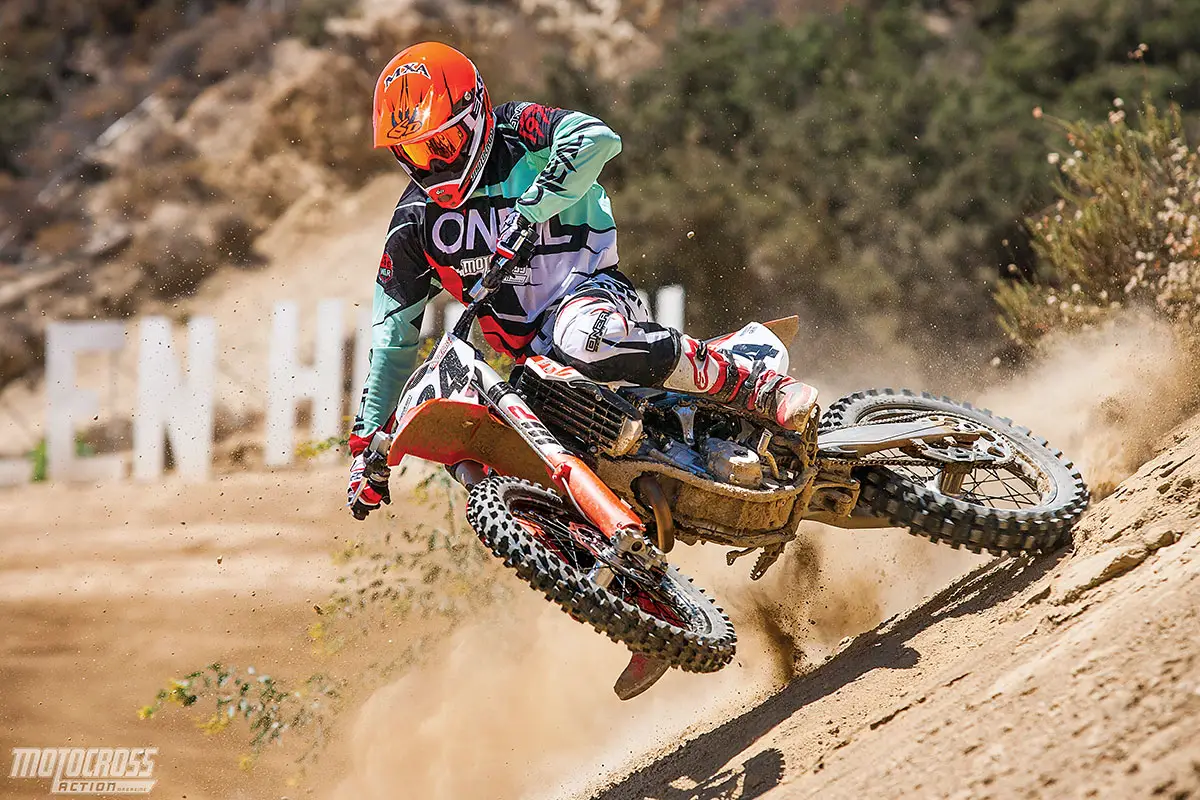
Q: FIRST AND FOREMOST, IS THE 2017 KTM 350SXF BETTER THAN THE 2016 350SXF?
A: Yes. But the big difference boils down to the switch from WP 4CS coil spring forks to WP AER air forks. There are other changes to the 2017 KTM 350SXF, though, and it is important that we look at each one to see what its contribution to the overall package is. Although this bike was designed when Giuspepe Luongo and Steve Whitelock were talking about having 350cc bikes replace 450s, which never happened, it has still managed to be a big seller for KTM—even though it is an orphan bike without a class. However, Vets and Professional Practice Riders adopted it immediately.
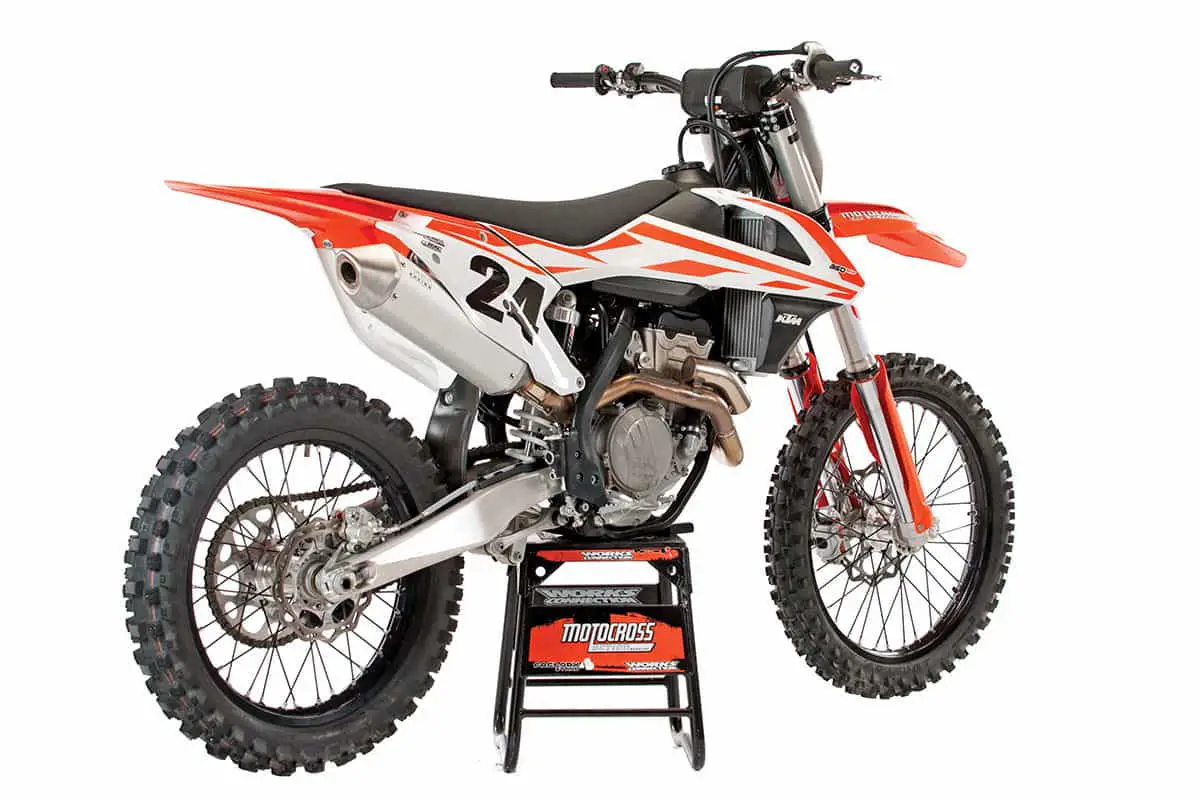
Q: HOW BIG IS THE CONTRIBUTION OF THE WP AIR FORKS?
A: Massive. Not only do KTM’s new air forks work, but they work very well. They are simple to adjust, easier to live with than the Rube Goldberg Showa SFF TAC forks and Kayaba PSF-2 forks, and they are 3.6 pounds lighter.
Q: HOW BIG IS THE CONTRIBUTION OF THE REDESIGNED TRIPLE CLAMPS?
A: Noticeable. Beefing up the structure of the top triple clamp and eliminating the milled hole in the front portion makes the 2017 top triple clamp more rigid. When we visited the KTM factory a while back, we shuffled through a box of prototype triple clamps and noticed the one that would become OEM in 2017. KTM said that it was too rigid for the 4CS forks, but KTM’s engineers must now feel that it has the perfect characteristics for the AER fork. Most test riders feel that the steering input on the 2017 is more accurate than on the 2016.
Q: HOW BIG IS THE CONTRIBUTION OF THE STRONGER HANDLEBAR CLAMPS?
A: Unimportant. Stay with us, because this gets a little confusing. In 2016 the bars were mounted to a one-piece lower bar mount with two separate top bar-mount clamps. This year the bottom bar mounts are now two separate pieces while the top bar mount is one piece. KTM says this will prevent twisting, but we noticed no improvement in bar integrity, because technically there is no real difference. We run one-piece clamps top and bottom.
Q: HOW BIG IS THE CONTRIBUTION OF THE SOFTER SHOCK SPRING RATE?
A: That depends. We had issues with WP’s choice of rear shock spring in 2016. The 2016 KTM 350SXF’s stock 48 N/m shock spring worked best for riders above 180 pounds (and even then it operated with very little preload on the spring). Riders under 180 pounds could not get any preload on the 48 N/m spring, and most MXA test riders switched to a 45 N/m shock spring. Good news: For 2017, the 450SXF gets a 45 N/m spring. The 350SXF, 250SXF and 250SX come with 42 N/m springs, while the 125SX and 150SX two-strokes are spec’ed with 39 N/m springs. We think that the 2017 KTM shock spring rates are more in line with the target weight of the potential buyer, but that doesn’t mean that the 42 N/m spring will be right for every 350SXF racer. If you are heavier, you will want to go up to the 45 N/m or even the 48 N/m spring.
Q: HOW BIG IS THE CONTRIBUTION OF THE MAP SWITCH?
A: Slight. KTMs have come with optional ignition maps for years, but accessing the maps hasn’t always been easy. Last year there was a flick switch on the right side of the handlebars that could be used to activate the stock map or a second map, either mellow or aggressive. The second map was chosen by rotating a dial inside the airbox. You would be amazed how many KTM racers didn’t know about the dial in the airbox or adjusted it improperly when they did know about it. For 2017 KTM has a new multi-switch on the left side of the handlebars. When you press the rubber-covered button on the bottom of the multi-switch, a lighted number is displayed on the face of the multi-switch. Number 1 is stock and number 2 is aggressive. Every MXA test rider chose to run the aggressive map. There is no dial in the airbox to bother with, and, by the same token, there is no mellow map option. The new multi-switch is easier to use than the flick switch but not a game-changer.
Q: HOW BIG IS THE CONTRIBUTION OF TRACTION CONTROL?
A: Overblown. KTM added traction control to the 2017 KTM four-stroke lineup. It works by monitoring runaway revs. The ECU recognizes runaway revs as an indicator that the engine is free-revving and the rear wheel is spinning. To stop the wheel from spinning, the ECU retards the ignition to slow the engine down and get the wheel hooked up again. To engage KTM’s traction-control system, you press the rubber-covered button on the top of the multi-switch until the letters “TC” light up in the switch’s window. As long as TC is showing, the KTM 350SXF is functioning with traction control. What did we think? It does exactly what it is designed to do, but we found limited use for it. MXA test riders only used KTM’s traction control in places where they used last year’s mellow map. It works best on hard-pack, rock-hard, muddy or slippery track surfaces. When we engaged traction control on a loamy track, it was more of a hindrance than a benefit.
Q: HOW BIG IS THE CONTRIBUTION OF LAUNCH CONTROL?
A: Positive. MXA test riders rarely use launch control on dirt starts, but we use it all the time on concrete or hard-packed dirt. On the 2017 KTM 350SXF you engage launch control by pressing the rubber-covered map button and the traction-control button simultaneously—easier said thatn done. If you do this properly, the light behind the front number plate will flash rapidly. The flashing light confirms that traction control is activated. Most MXA test riders engage traction control, hold the throttle wide open, and then dump the clutch. It sounds like it couldn’t possibly work, but it does. There is one caveat, though. If you blip the throttle on the starting line and let the revs fall by more than 30 percent, launch control will shut off—and you cannot reengage it without shutting the engine down. Why does it disengage launch control if the revs fall? The system is designed to stay engaged as long as the rider is moving forward. Once he shuts the throttle off for the first turn, the system disengages.
Q: HOW BIG IS THE CONTRIBUTION OF THE NEW REAR BRAKE SETUP?
A: Welcome. For 2017 KTM made two changes to the rear brake system. (1) Longer brake pedal. The 2017 rear brake pedal is 10mm longer than the 2016 pedal. We recognized that the KTM brake pedal was too short several years ago and always ran 7602 Racing’s 10mm-longer brake-pedal tip (www.7602racing.com). (2) Rear brake pads. For 2017 the rear brake pads use a less-aggressive compound. Many racers felt that the previous rear brake pad was too grabby and could overheat if used too aggressively. If you liked last year’s feel, just order 2016 brake pads for your 2017 KTM. If you feel the new pads are too grabby and squeal a little, grind a slope on the front edge of the pads to allow them to engage cleaner. Take precautions not to breathe in the brake dust when grinding the angle on the brake pads
Q: HOW BIG ARE THE CONTRIBUTIONS OF THE MISCELLANEOUS UPDATES?
A: Very big. Every 2017 KTM comes with an hour meter installed on top of the top triple clamp. This is a nice touch. The head stays are not only aluminum and more rigid than the steel stays of 2016, but they look nicer and are lighter. The seat cover has a new gripper material that is like Mamma Bear’s porridge—not too grippy and not too slick. The top of the shock body now has a raw-aluminum cap instead of a black-anodized one. It doesn’t do anything functional, but it adds a light touch to the chassis. The graphics mystify us. Last year, if you looked closely, you could see the letters KTM cryptically hidden in the radiator-shroud design. We’ve been looking at the 2017 graphics to find the hidden message, but it has eluded us.
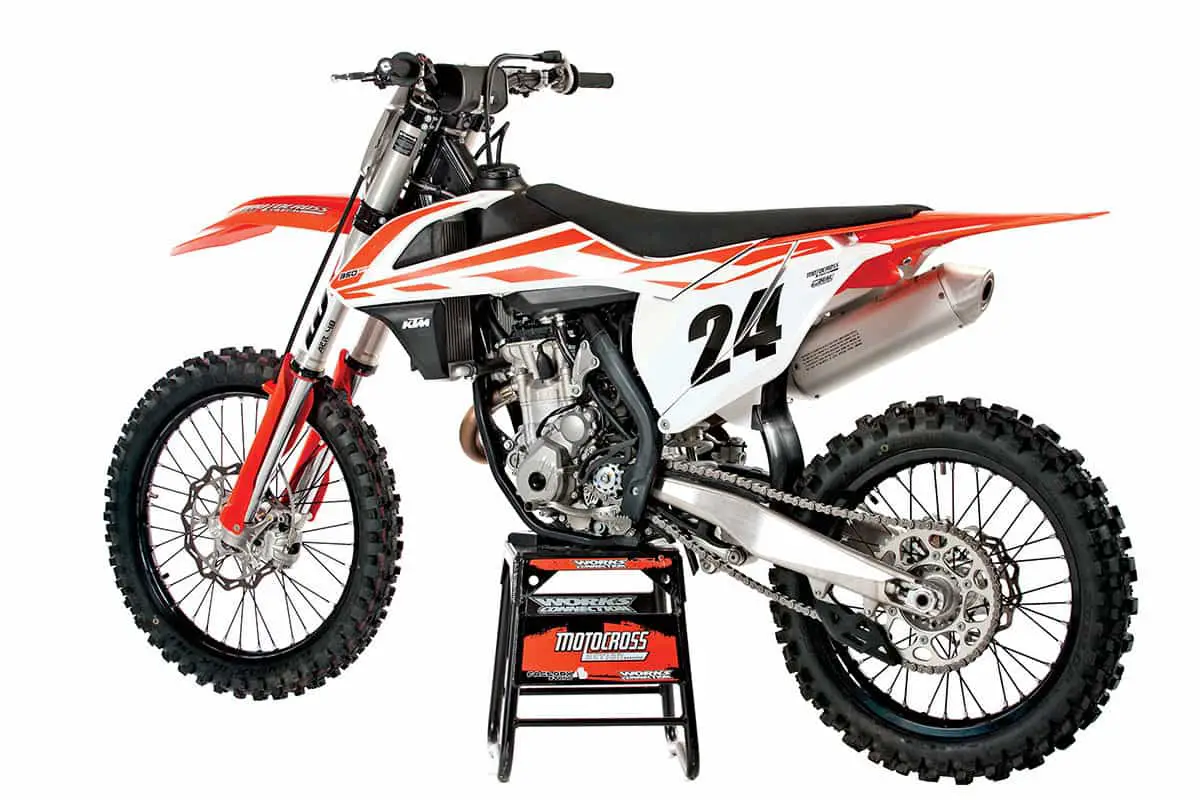
Q: HOW FAST IS THE 2017 KTM 350SXF?
A: The 2017 KTM 350SXF may not be everybody’s cup of tea, but it is a very sweet powerband that can be used two ways:
(1) Ride it hard. If you want all the horsepower that the 350SXF has to offer, you need to rev it to the moon—and we mean rev it until dogs howl in neighboring towns. The key tactic to being successful on a 350SXF is to refuse to shift. Resist the urge to shift when your twitchy right foot wants you to. Resist the urge to shift when the engine whines at 11,000 rpm. Resist the urge to shift until your brain can’t take it anymore. Then, at 13,400 rpm, and not one iota earlier, slam in a new gear and refuse to shift all over again. Why should you bleed it dry? Because if you shift at 9000 rpm, you will be giving up 5 horses. If you shift at 11,000 rpm, you will be giving up 1 horse. If you shift at 13,400 rpm, you will be getting everything the 350SXF has, which is 54.41 horsepower.
(2) Ride it easy. What’s great about the progressive nature of the powerband is that it is flexible enough to meter out the correct amount of power for every track situation. It has the perfect power below peak rpm to master tricky half-throttle corners. It can track across off-cambers without raising your fear of spinning out. It picks up clean, builds power progressively and keeps its eye on the prize, even if you never get near the 13,400-rpm grand prize. Many Vet riders love to race the 350SXF as though it were a small 450 instead of what it really is—a big 250.
Is it faster than last year’s KTM 350SXF? No. There are no cam, valve, piston or exhaust-pipe mods. Mechanically, the 2017 engine is the 2016 engine, although there is a mapping change that makes it feel smoother.
Q: HOW GOOD ARE THE 2017 WP AER FORKS?
A: WP’s take on air fork is so different from Showa’s and Kayaba’s concept that you almost think they are existing in a parallel universe. The WP AER fork doesn’t try to reinvent the wheel; it just replaces the coil springs with air—and uses the recycled air to damp the fork on its return stroke (much as a modern rifle uses excess gases to reload the next shell). And, it does this with no added moving parts. Think of the air cartridge on a WP AER fork as a bicycle pump tucked inside the right fork leg. Just like a bicycle pump, the WP cartridge has a piston that goes up and down, changing the air pressure as it goes. On the downstroke, the pressure builds up; on the upstroke, thanks to a simple little bypass dent, the same air is recycled to the other side of the piston to stop the fork from topping out. In a single up-and-down movement, WP is able to use the same air pressure in two different directions.
Finally, to quote President Gerald Ford, “My fellow Americans, our long national nightmare is over.” We can forget the tortures that WP put us through these last few decades and focus on going fast without bottoming, chattering or crying. KTM’s AER air forks are the best iteration of air technology on the track—not just because they work so well, but because they are easy to live with. You can race these forks right off the showroom floor.
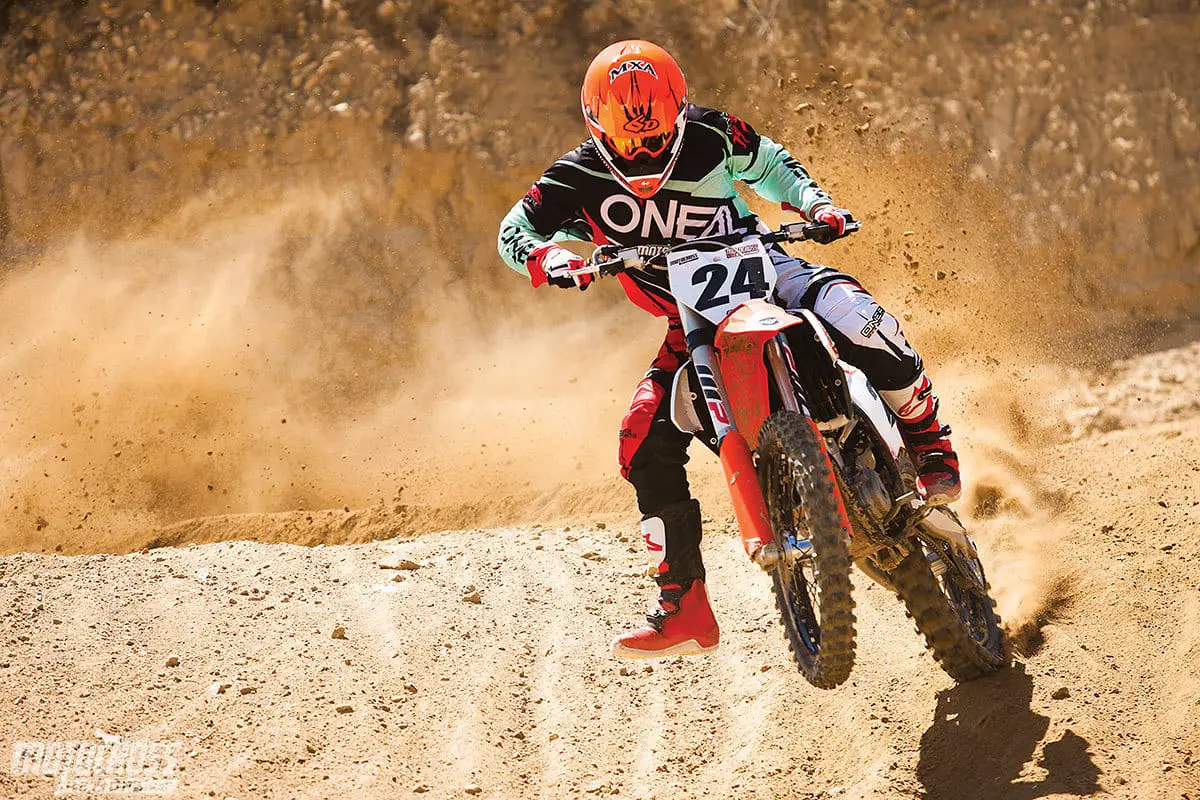
Q: HOW MUCH DOES THE 2017 KTM 350SXF WEIGH?
A: On MXA’s scales, it came in at 221 pounds. That makes the 350SXF lighter than every Japanese 250, but on one pound lighter than a 2017 KTM 450SXF.
Q: HOW MUCH DOES THE 2017 KTM 350SXF COST?
A: Here is the complete price spread for the 2017 KTMs: The 125SX two-stroke costs $6899. The 150SX two-stroke costs $6999. The 250SX two-stroke costs $7699. The 250SXF costs $8499. The 350SXF costs $9199, and the 450SXF costs $9399.
Q: WHAT DID WE HATE?
A: The hate list:
(1) Fork-air bleeder. Even if you own a #20 Torx wrench, never use it on the air side of the WP forks. It will strip out. Just use a 10mm T-handle. On the left side you have to use the #20 Torx, but at least this screw is made from steel. we put in the Phillips head screw from old model WP forks.
(2) ODI grips. Oh, don’t get us wrong, we like the ODI lock-on grips, but the clutch side is locked on with a #15 Torx. Yeah, we don’t own one of those, either.
(3) The pipe. You can’t take the pipe off the bike without removing the shock or the swingarm. Take your pick.
(4) Gas cap. It sticks. Sometimes you don’t think it will ever come loose.
(5) Sprocket bolts. Unlike the gas cap, they come loose constantly. Never trust that they are tight and you will never have any trouble.
(6) Spokes. Our spokes never took a set. Every couple motos we would check the spoke next to the rim lock and it would be loose. If it’s loose, the other spokes will be loose very soon. We have broken KTM spokes in 2017.
(7) Front brake hose. Be very careful when hooking tie-downs onto your handlebars that they don’t crimp the L-bend tube coming out of the front brake’s master cylinder. We would prefer more room between the brake line and the bars to lessen the chance of damage.

Q: WHAT DID WE LIKE?
A: The like list:
(1) Handling. You don’t have to point it where you want it to go; you just have to think it.
(2) Hydraulic clutch. This clutch is stout enough to last a full race season without being touched.
(3) Weight. You have to be impressed by the 221-pound weight. This is an impossible dream achieved with a battery and electric starter.
(4) Powerband. Even though the MXA wrecking crew thinks that a 375cc, 380cc or 400cc displacement would come closer to fulfilling the dream of a mid-size Open-class bike, the 350SXF is the ultimate expression of a 250 on steroids.
(5) Tires. We like the Dunlop MX3S intermediate tires, but be forewarned that if you run them on hard-pack dirt, the side knobs will rip off the front tire.
(6) Hour meter. Kudos to KTM for putting an hour meter on its bikes at the factory—and saving us the trouble.
Q: WHAT DO WE REALLY THINK?
A: Pinch yourself. Not just because the 2017 KTM 350SXF suddenly has forks that work, but because KTM was brave enough to build something unique, with a different displacement, electric starting, hydraulic clutch, the world’s simplest air filter, awesome brakes, superb handling and value in every part. This is a dream bike for a large portion of motocross riders. And if you don’t believe it, try to buy a Honda CRF350, Yamaha YZ350F, Suzuki RM-Z350 or Kawasaki KX350F. Dream on.
MXA’S KTM 350SXF SETUP SPECS
This is how we set up our 2017 KTM 350SXF for racing. We offer it as a guide to help you find your own sweet spot.
WP AER FORK SETTINGS
The air pressure on every AER fork varies from KTM model to KTM model. The 125SX and 150SX use 125 psi. The 250SX has 148 psi. The 250SXF and 350SXF come with 154 psi, and the 450SXF is set at 156 psi. But, you aren’t locked into those numbers. Most MXA test riders ran lower air pressures in the 350SXF forks. How do we arrive at the proper air pressure? With a two-pronged approach. First, we start with the OEM recommended air pressure and note how high the forks ride in their stroke and how much travel they get over the jumps (with a zip-tie on one fork leg). With the stock air pressure, the AER forks typically ride high in their stroke and come up about 3 inches short of bottoming. Then we lower the air pressure in 2-psi increments. How do we know when we have the proper pressure? First, the forks don’t feel like they are dropping excessively into their stroke, and second, they are getting almost full travel. For hard-core racing, we recommend this fork setup on the 2017 KTM 350SXF (stock specs are in parentheses):
Spring rate: 140 psi (154 psi)
Compression: 20 clicks out (12 clicks out)
Rebound: 15 clicks out (12 clicks out)
Fork-leg height: Third line
Notes: Slower or lighter riders might have to lower the oil height in the damping leg by 10mm or more to get full travel (although we have had good luck with them lowering the air pressure as low 133 psi. Additionally, pay attention to extreme temperature changes, you may have to change the AER’s air pressure as it gets hotter later in the day. However, we do bleed the outer chamber constantly, which is accessed via a 10mm hex head or #20 Torx. Even if you own a #20 Torx, don’t use it because it strips out easily.
WP SHOCK SETTINGS
Last year the KTM 350SXF came with a very stiff 48 N/m shock spring. Many riders had trouble getting any preload on the shock spring. We swapped all of our 48 N/m springs for the lighter 45 N/m spring from the 250SXF. For 2017 KTM is lowering all of its motocross bike spring rates, which means that the 2017 350SXF will have a 42 N/m spring stock. If you are around 180 pounds, you might want to go to a 45 N/m spring. If you are over 200 pounds, you will probably want to return to the 48 N/m spring. For hard-core racing, we recommend this shock setup for the 2017 KTM 350SXF (stock specs are in parentheses):
Spring rate: 42 N/m
Race sag: 105mm (110mm)
Hi-compression: 1-3/4 turns out (2 turns out)
Lo-compression: 15 clicks out
Rebound: 10 clicks out (15 clicks out)
Notes: We turned the high-speed compression damping in a little to lessen G-outs and ran a touch more rebound than the recommended setting. Additionally, we set the sag at 105mm instead of the WP-recommended 110mm.
MXA’S FIRST RIDE! 2017 KTM 350SXF


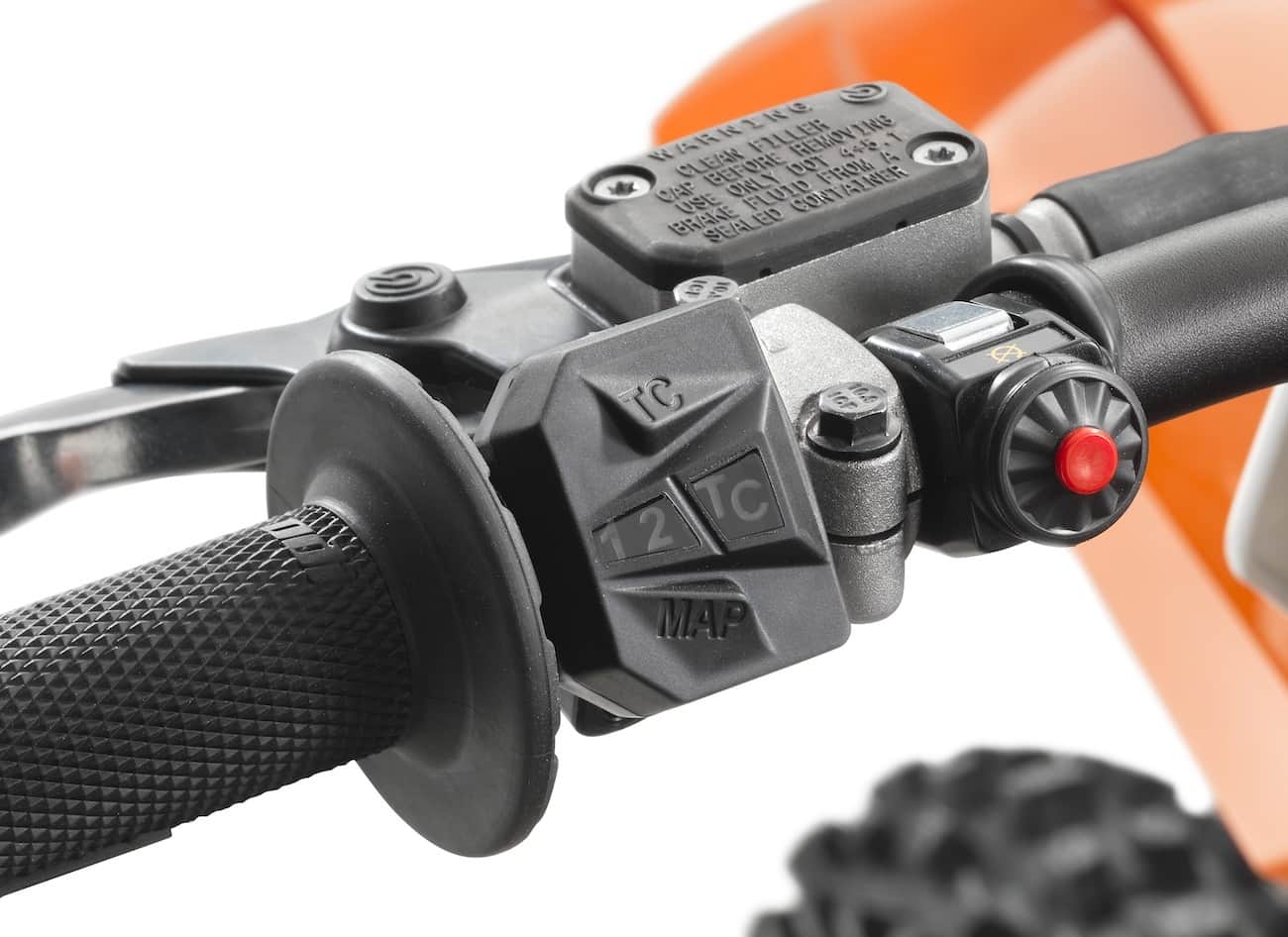

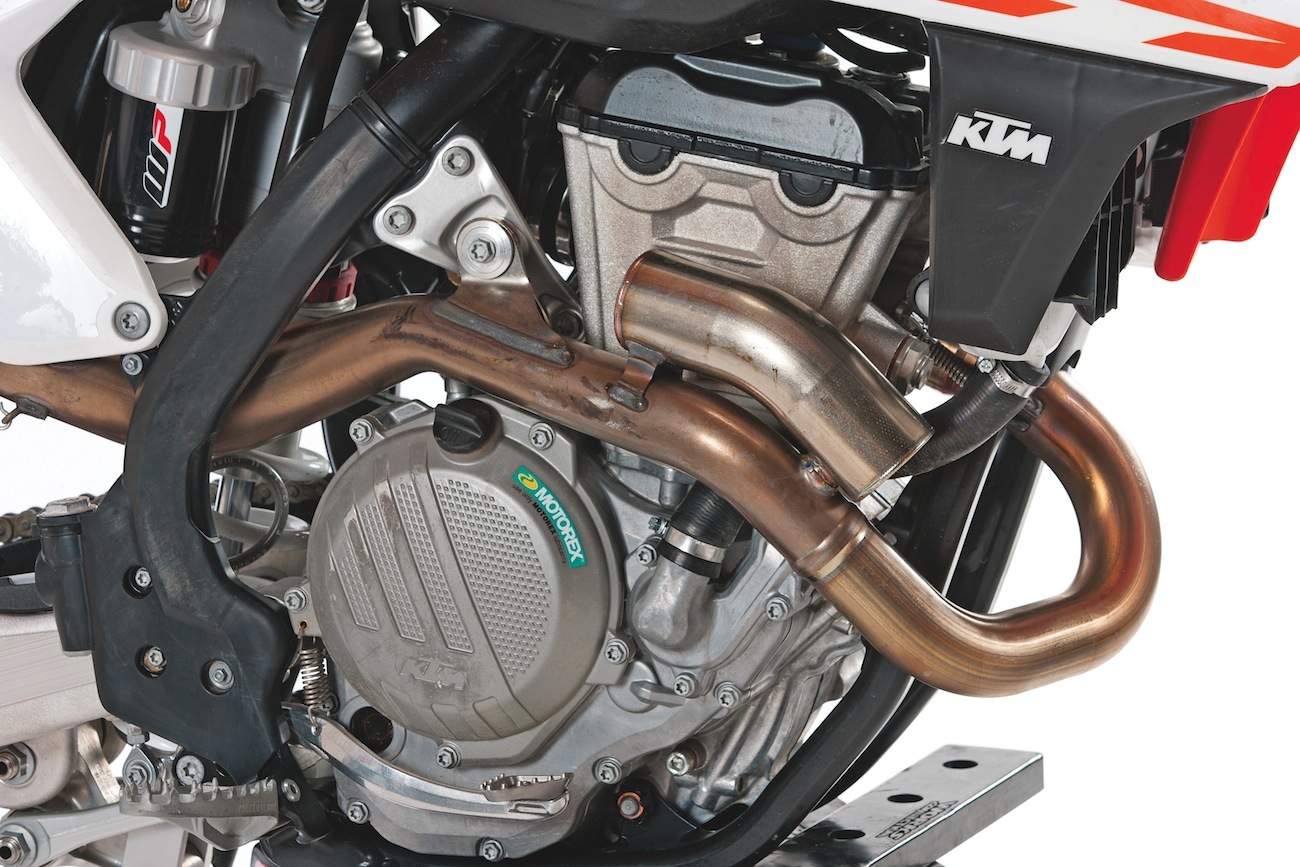

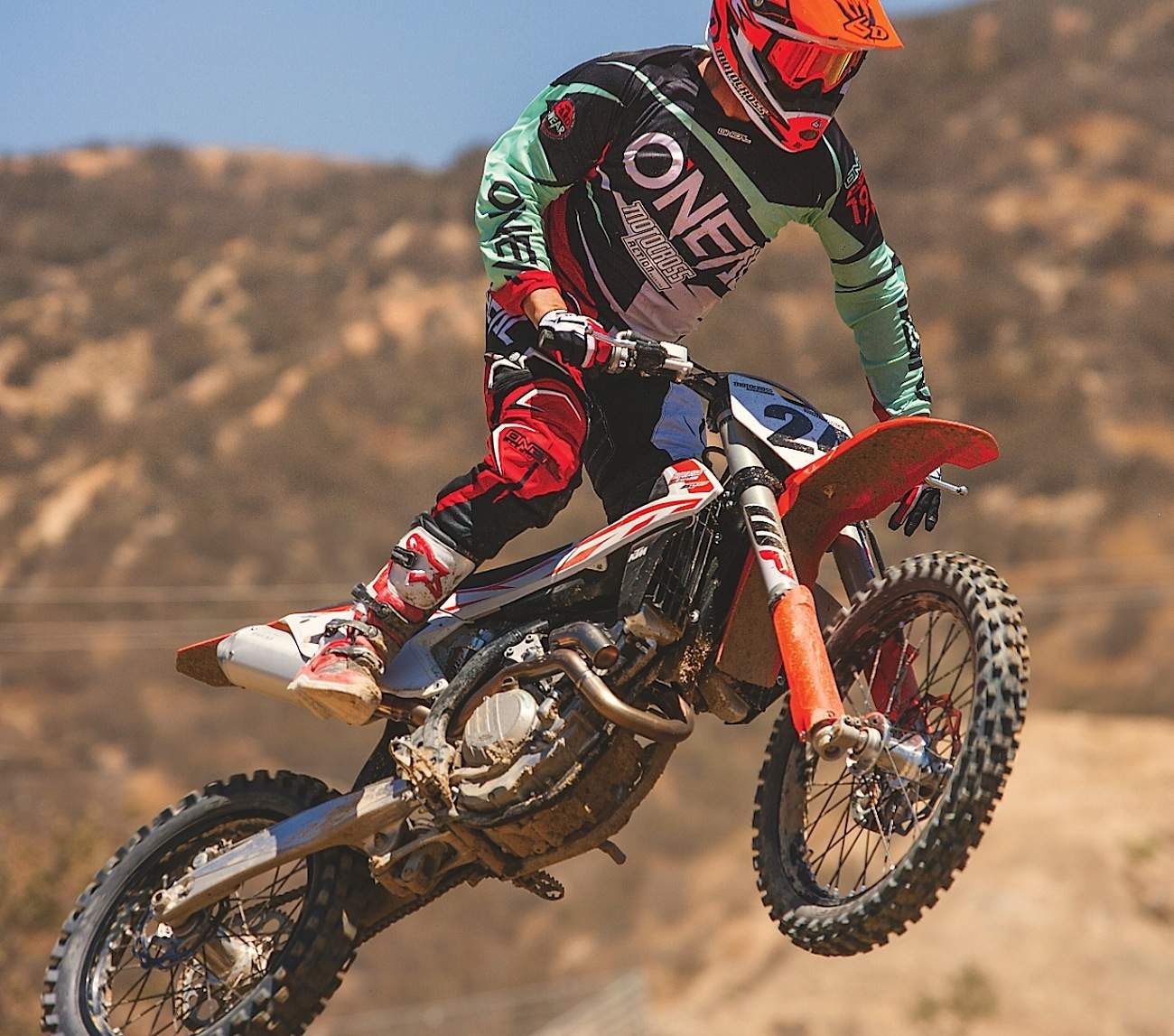

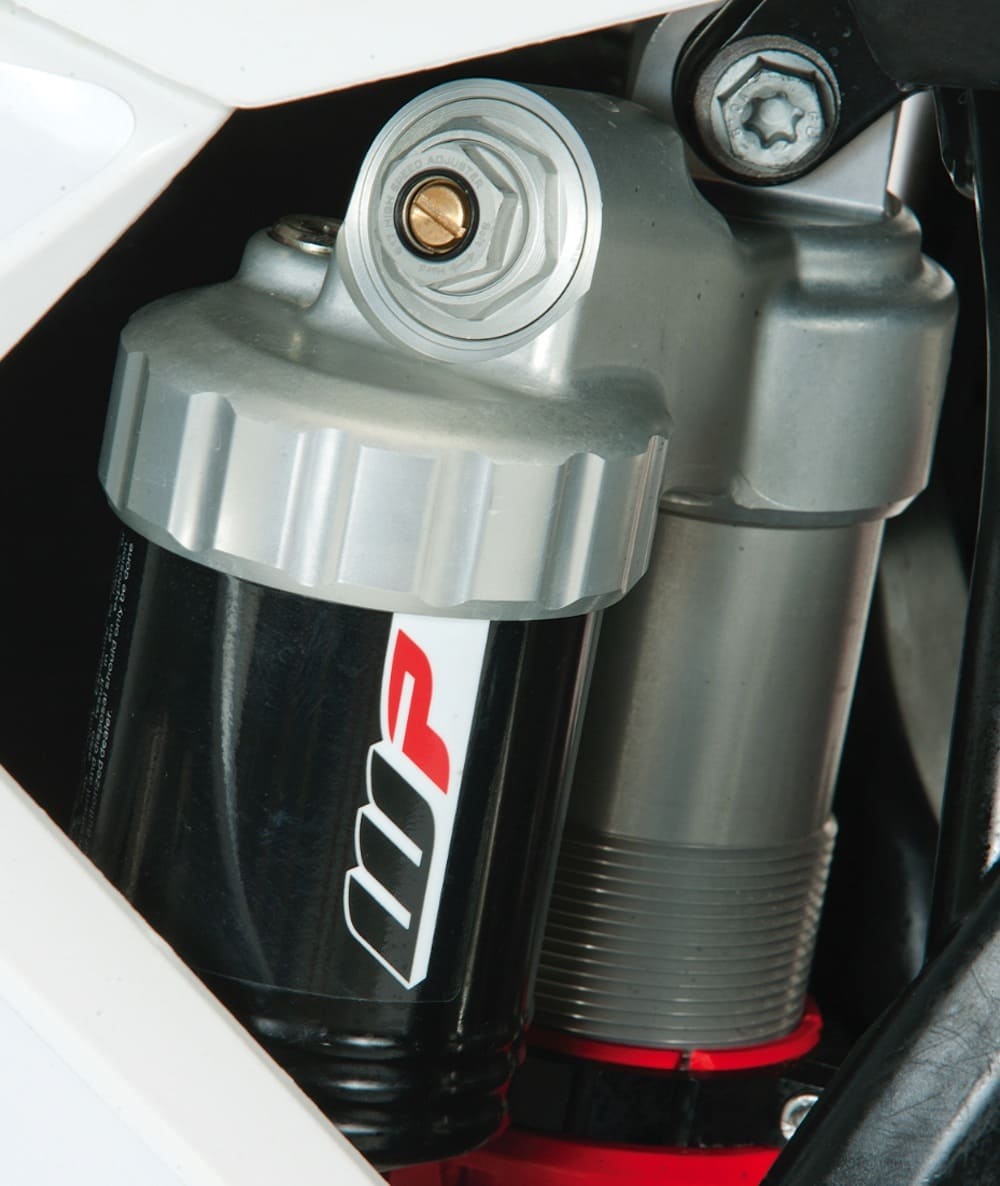



Comments are closed.